
Caladenia fuscata, commonly known as dusky fingers, is a plant in the orchid family Orchidaceae and is endemic to eastern and south-eastern Australia, including Tasmania. It is a small ground orchid found in eucalyptus woodland and which flowers in September and October.

Caladenia amoena, commonly known as charming spider orchid, is a plant in the orchid family, Orchidaceae, and is endemic to Victoria, Australia. It is a ground orchid which grows singly or in small groups, has a single dark green, hairy leaf and a single yellowish-green flower with red stripes. It is only known from a few sites and has been classified as Endangered.

Caladenia anthracina, commonly known as black-tipped spider orchid, is a plant in the orchid family Orchidaceae and is endemic to Tasmania. It is a ground orchid with a single hairy leaf and a single white or cream-coloured flower with red markings and black tips on the sepals and petals.
Caladenia atradenia, commonly known as bronze fingers, is a plant in the orchid family Orchidaceae and is endemic to New Zealand. It is a ground orchid with a thin, hairy leaf and a thin wiry stem bearing one or two dark green or greenish red flowers with maroon or magenta markings.
Caladenia atrochila is a plant in the orchid family Orchidaceae and is endemic to Tasmania. It is a ground orchid with a single hairy leaf and flowers that are whitish or pinkish on the front, but yellowish-green on the back and a cream-coloured labellum with dark red markings.
Caladenia atroclavia, commonly known as the black-clubbed spider orchid, is a plant in the orchid family Orchidaceae and is endemic to south-eastern Queensland. It is a ground orchid with a single hairy leaf and a pale greenish-cream coloured flower with dark purple clubs and red patches on the petals.
Caladenia brachyscapa is a plant in the orchid family Orchidaceae and is native to Victoria and possibly Clarke Island in Bass Strait. It is a ground orchid with a single hairy leaf and a reddish-pink flower with thick, black, club-like swellings on the petals and sepals. Although formally described in 1988 living specimens have not been observed since 1979.
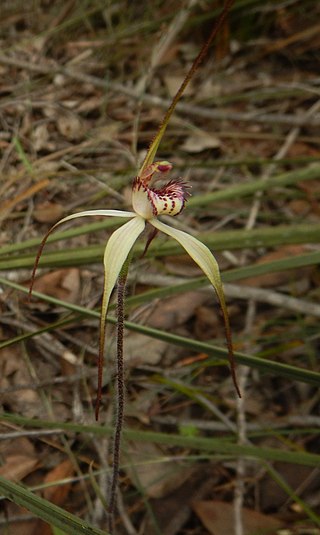
Caladenia brumalis, commonly known as winter spider orchid, is a plant in the orchid family Orchidaceae and is endemic to South Australia. It has an erect, hairy leaf and usually a single white to pinkish flower with darker markings. It is only found in a few places due to habitat loss and is considered to be vulnerable.
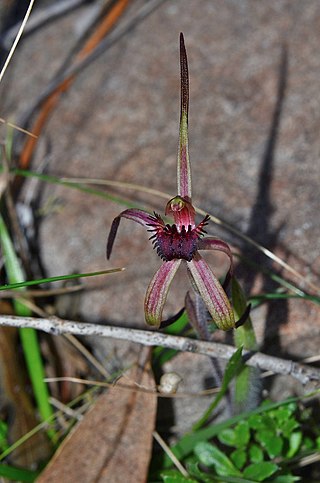
Caladenia caudata, commonly known as tailed spider orchid, is a plant in the orchid family Orchidaceae and is endemic to Tasmania. It is a ground orchid with a single hairy leaf and up to four red, or yellow and red flowers with dark red to almost black tips.
Caladenia cleistantha is a plant in the orchid family Orchidaceae and is endemic to the south-east of Australia. It is a ground orchid which occurs as solitary plants and has a singly hairy leaf and one or two cleistogamous flowers..
Caladenia coactilis, commonly known as thick fingers, is a plant in the orchid family Orchidaceae and is endemic to South Australia. It is a ground orchid which grows singly or in loose groups and has a single hairy leaf and one or two flowers which are bright pink inside and brownish on the back.
Caladenia colorata, commonly known as coloured spider-orchid, small western spider-orchid and painted spider-orchid is a plant in the orchid family Orchidaceae and is endemic to South Australia and possibly Victoria. It is a ground orchid with a single hairy leaf, and usually a single creamy-green flower with blood-red or purple-brown markings and with dark tips on the petals and sepals.
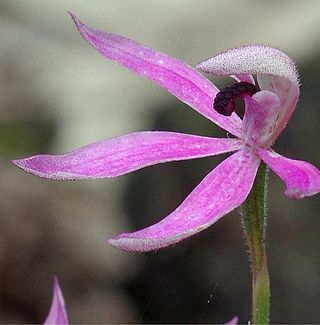
Caladenia congesta, commonly known as black-tongue caladenia, is a plant in the orchid family Orchidaceae and is endemic to Australia. It is a ground orchid with a single, sparsely hairy leaf, and up to three bright pink flowers with the central part of the labellum completely covered with black calli. It is a widespread species but not common in any part of its range.
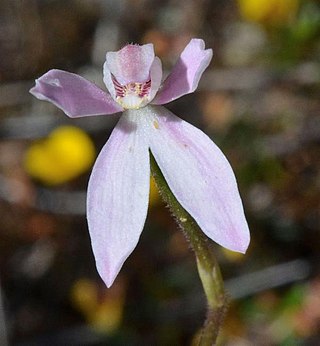
Caladenia cracens, commonly known as the elegant caladenia, is a plant in the orchid family Orchidaceae and is endemic to Tasmania. It is a ground orchid with a single, sparsely hairy leaf and a single pale to dark pink or mauve flower on a thin, wiry stem 5–18 cm (2–7 in) high.
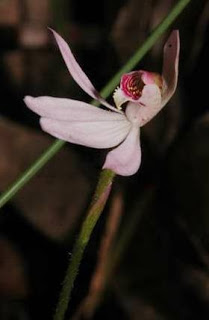
Caladenia curtisepala, commonly known as short-hooded fingers, is a plant in the orchid family Orchidaceae and is endemic to south-eastern Australia. It is a ground orchid with a single hairy leaf, and a single white to cream-coloured flower with a white labellum with red bands.
Caladenia dienema, commonly known as the windswept spider-orchid, is a plant in the orchid family Orchidaceae and is endemic to Tasmania. It is a ground orchid with a single, hairy leaf and a single, variably-coloured, usually dark red flower on a thin, wiry stem 5–12 cm (2–5 in) high.
Caladenia helvina, commonly known as the summer spider orchid, is a plant in the orchid family Orchidaceae and is endemic to Tasmania. It is a ground orchid with a single hairy leaf and usually a single greenish-yellow to pale yellow flower with reddish teeth on the sides of the labellum and reddish calli along its mid-line.

Caladenia hillmanii, commonly known as purple-heart fingers, is a plant in the orchid family Orchidaceae and is endemic to New South Wales. It is a ground orchid with a single leaf and one or two bright pink flowers with a reddish-purple labellum with darker bars.

Caladenia transitoria, commonly known as green caps, is a species of orchid endemic to south-eastern Australia. It has a single, long, erect, hairy leaf and one or two greenish-yellow flowers with purplish backs.
Caladenia rosea is a plant in the orchid family Orchidaceae and is endemic to relatively inaccessible, high lateritic plateaux in a high rainfall area in south-western Western Australia. It is a terrestrial orchid with a single hairy leaf and up to three pink flowers on a thin, sparsely-hairy stem. It is similar to Caladenia flava but is distinguished by the perianth being pink to dark pink with prominent red striping and spotting on the dorsal sepal and lateral petals. Caladenia rosea mimics Hypocalymma robustum (Myrtaceae) in terms of flowering time, colour and scent.









